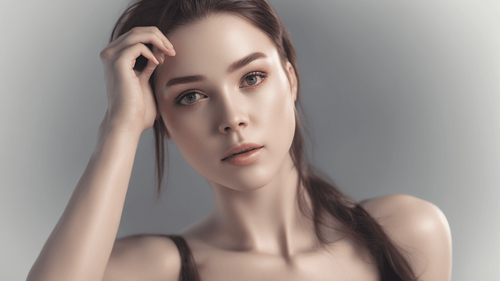
Introduction
In an era where technological advancements continuously redefine our reality, the emergence of AI-generated pictures of yourself has taken personalization and creativity to unprecedented heights. Imagine having a digital doppelgänger that can capture your essence with remarkable accuracy, opening doors to imaginative possibilities that were once confined to the realm of science fiction.
Unveiling AI Generated Pictures
Understanding AI-Generated Imagery
AI generated pictures of yourself are the result of cutting-edge artificial intelligence algorithms that analyze vast datasets of facial images and patterns. These algorithms then learn to replicate the unique features, expressions, and even nuances of your face. This intricate process involves complex deep learning networks that gradually refine the output to achieve strikingly realistic visuals.
The Marriage of Generative Adversarial Networks (GANs) and Facial Recognition
At the heart of AI-generated pictures lies the synergy between Generative Adversarial Networks (GANs) and facial recognition technology. GANs consist of two neural networks—the generator and the discriminator—locked in a creative battle. The generator crafts images, attempting to mimic reality, while the discriminator critiques its efforts. This dynamic fosters a continuous refinement process, resulting in images that are remarkably authentic.
Revolutionizing Personalization
The implications of AI-generated pictures are profound, particularly in the realm of personalization. Individuals can now visualize themselves in various scenarios, outfits, and even ages. This technology breathes life into creative self-expression, enabling users to see themselves as artists, historical figures, or characters from their favorite novels.
The Inner Workings of AI Generated Pictures
Data Collection and Preprocessing
The journey towards an AI-generated depiction of oneself begins with the collection of diverse facial images. These images encompass a myriad of expressions, lighting conditions, and angles to ensure a holistic dataset. Preprocessing, involving tasks such as normalization and augmentation, readies the data for the subsequent AI training process.
Training the Deep Learning Model
Deep learning models, often convolutional neural networks (CNNs), are the backbone of AI-generated imagery. The model learns intricate facial features by identifying patterns within the training data. This stage involves countless iterations, as the model continuously refines its understanding of human facial structures.
Fine-Tuning and GAN Integration
Fine-tuning involves honing the model's capabilities to generate images with exceptional realism. GANs then enter the scene, with the generator creating images and the discriminator providing constructive feedback. Through this adversarial dance, the AI gradually produces pictures that are eerily convincing.
Applications Across Industries
Fashion and E-Commerce
AI-generated pictures have ignited a revolution in the fashion and e-commerce sectors. Shoppers can now envision themselves wearing a variety of outfits, empowering them to make informed decisions when shopping online. This technology bridges the gap between the digital and physical shopping experiences.
Entertainment and Gaming
Entertainment and gaming industries have harnessed the power of AI-generated imagery to enhance user engagement. Players can insert their digital likenesses into games, creating immersive experiences that blur the lines between reality and virtuality. This personalization fosters deeper connections between users and their digital avatars.
Marketing and Branding
Marketers are capitalizing on the allure of personalized advertisements. By integrating AI-generated images, brands can create campaigns that resonate with individual consumers on a deeper level. This tailored approach enhances brand loyalty and fosters emotional connections.
Navigating Ethical and Privacy Frontiers
Ownership and Consent
The rise of AI-generated pictures sparks discussions surrounding ownership and consent. As individuals share their facial data, questions arise regarding who owns the resulting images. Striking a balance between personalization and privacy remains a crucial challenge.
Potential Misuse and Manipulation
The immense realism of AI-generated imagery raises concerns about potential misuse and manipulation. From deepfake videos to fabricated images, there is a need for vigilant monitoring and regulations to prevent malicious exploitation.
FAQs
How does AI generate pictures of yourself?
AI generates pictures of yourself through deep learning models, utilizing GANs to create and refine images that resemble your facial features.
Can AI-generated pictures replace traditional photography?
While AI-generated pictures offer innovative possibilities, traditional photography continues to capture genuine moments and emotions that AI cannot replicate.
Is AI-generated imagery always accurate?
AI-generated imagery aims for realism, but variations and inaccuracies can occur. It's a simulation, not a perfect replica.
What are the privacy implications of AI-generated pictures?
AI-generated pictures raise concerns about facial data privacy. Users should be cautious while sharing personal images and data.
Can AI-generated pictures be used maliciously?
Yes, AI-generated pictures can be misused for creating deepfakes or impersonations. Vigilance and awareness are essential to counter potential misuse.
What industries benefit the most from AI-generated imagery?
Fashion, entertainment, gaming, and marketing are some of the industries that leverage AI-generated imagery for enhanced personalization.
Conclusion
AI-generated pictures of yourself represent a groundbreaking convergence of creativity, personalization, and technology. As this technology continues to evolve, it holds the potential to reshape how we perceive ourselves and interact with digital realms. By embracing responsible usage, ethical considerations, and ongoing innovation, we can unlock the full spectrum of possibilities that AI-generated imagery offers—ushering in a new era of visual self-expression and exploration.